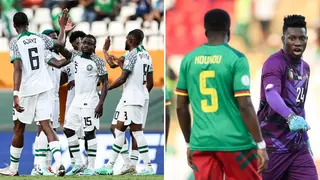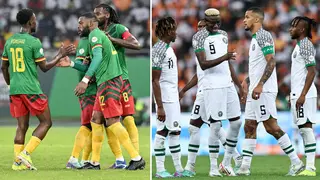Nigeria’s Super Eagles get AFCON boost as injured star returns ahead of Cameroon clash
Football
The 2023 Africa Cup of Nations (AFCON) has exceeded all expectations, soaring to heights previously unimaginable when the tournament kicked off in Ivory Coast.
With jaw-dropping results, stunning upsets, tactical masterstrokes, and nail-biting penalty shootouts, the AFCON has captivated fans far beyond their wildest dreams.
Nigeria’s Super Eagles have emerged as one of the tournament's most remarkable stories. Despite being perennial powerhouses in African football, their journey to the competition was fraught with doubts and setbacks.

Under Jose Peseiro's guidance, the team stumbled with draws against Lesotho and Zimbabwe before suffering a humiliating defeat to Guinea’s Sylli Nacional.
Nigeria’s Super Eagles get AFCON boost as injured star returns ahead of Cameroon clash
Football
PAY ATTENTION: stay informed and follow us on Google News!
These disappointing performances only fuelled the scepticism surrounding the Super Eagles, with many predicting their downfall at the tournament's outset.
Although their opening match against Equatorial Guinea’s Nzalang Nacional ended in a lacklustre draw, the Nigerian team refused to be disheartened.
Undeterred by their initial setback, the coaching staff made a bold tactical adjustment, switching from the expected 4-3-3 formation to a dynamic 3-4-3 setup.
This strategic shift proved to be a game-changer, propelling the Super Eagles to their first AFCON final in over a decade.
In light of their recent success with this revamped formation, Sports Brief delves into the tactics, highlighting three key advantages of their newfound approach.
The Super Eagles have undergone a remarkable change, evolving from a defensively vulnerable team into one of the most formidable defensive units at the tournament.
AFCON 2023: Nigeria’s Super Eagles defender confident ahead of Cameroon clash
Football
At the core of this transformation lies the formidable trio of Semi Ajayi, William Troost-Ekong, and Calvin Bassey, who together create an impregnable barrier in front of the impeccable goalkeeper, Stanley Nwabali.
Their aerial prowess, physical strength, and tactical awareness make them adept at thwarting the pace and skill of opposing attackers. Remarkably, Nigeria's defence has conceded just twice in over nine hours of play at the AFCON.
The midfield pairing of Frank Onyeka and Alex Iwobi have forged a dynamic partnership with the energetic fullbacks, Ola Aina and Zaidu Sanusi.
Their collective influence shapes the rhythm of the game. Onyeka's relentless determination and prowess in winning the ball perfectly complement Iwobi's vision, creativity, and knack for piercing through defences with pinpoint passes.
Meanwhile, Aina and Zaidu's proficiency in surging down the flanks adds an extra dimension to both the team's attacking prowess and defensive solidity, enabling the Super Eagles to maintain control of the match even when not in possession.
AFCON 2023: Super Eagles legend states what Nigeria must do to defeat Cameroon
Football
At the forefront of coach Peseiro’s formation stand the attacking triumvirate of Ademola Lookman, Moses Simon, and Confederation of African Football (CAF) Player of the Year, Victor Osimhen.
With their seamless coordination, this attacking trio instils fear in the hearts of opposing defences.
Lookman's finesse and dribbling wizardry, coupled with Osimhen's deadly finishing and Moses Simon's electrifying speed, forge a formidable attacking unit capable of breaching even the most resolute defences.
As Nigeria prepares to face Ivory Coast in the final at the Stade Alassane Ouattara, supporters of the Super Eagles fervently hope for a replication of the team's impressive performances with this new formation.
In another report, Sports Brief stated that Nigeria forward Victor Osimhen recounted his ordeal at the hospital ahead of the semi-final clash against South Africa.
The 25-year-old had been diagnosed with an abdominal problem in the lead-up to the pulsating encounter.
However, the Napoli forward shook off the pain and helped his nation secure a spot in the final of the tournament.